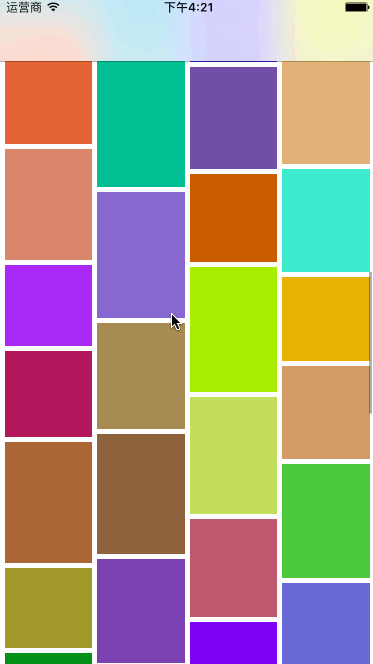
- IOSXib使用——为控制器添加Xib文件
- 音乐社交APP源码V1.1
- OC中线程的状态相关
- 【学习笔记】【C语言】递归
- [ios]scrollView实现移动与缩放
- IOS百度地图导航开发功能实现简述
- ios-获取系统相簿里边的所有照片
- iOS从xib中加载自定义视图
- 【学习笔记】【C语言】结构体的嵌套
- IOS证书之Certificates,Devices,Identifiers&Profiles
- [iOS基础控件-4.3]APP列表xib的使用
- 一周随笔--15.10.27
- UI音乐播放之初级篇AVAudioPlayer
- ios开发-UI基础-应用管理(单纯界面)改进5-使用代理实现监听下载按钮的点击(delegate)
- 一周随笔--15.9.28
- 2015年iOS测试现状
- 一种头像缓存策略
- iOS中获取文件路径的几种方法
- CoreAnimation-07-CAAnimationGroup
- XCODE6+ios8真机调试[转]
- iOS学习笔记之typedef
- iOS拷贝、剪切和粘贴理论基础(转)
- IOS开发基础知识--碎片17
- 【学习笔记】【C语言】结构体
- OC语言中BOOL和bool区别
- IOS,极方便地添加约束-Masonry
- 3D地图导航应用源码
- iOS阶段学习第32天笔记(页面传值方法介绍)
- cordova创建ios项目
- IOS学习笔记2015-03-22OC-API-日期
IOS简单实现瀑布流UICollectionView
作者:佚名 IOS开发编辑:admin 更新时间:2022-07-23
UICollectionView 比tableView 灵活,功能也强大很多。系统实现了流式布局,但用处还有很多限制。
要想实现更灵活的布局,就咬重写UICollectionViewLayout。
先看下实现效果:

废话不多说,直接上代码:
先看WaterfallCollectionLayout.m
#import "WaterfallCollectionLayout.h" #define colMargin 5 #define colCount 4 #define rolMargin 5 @interface WaterfallCollectionLayout () //数组存放每列的总高度 @property(nonatomic,strong)NSMutableArray* colsHeight; //单元格宽度 @property(nonatomic,assign)CGFloat colWidth; @end
该类要重写以下方法:
//完成布局前的初始工作 -(void)prepareLayout; //collectionView的内容尺寸 -(CGSize)collectionViewContentSize; //为每个item设置属性 -(UICollectionViewLayoutAttributes *)layoutAttributesForItemAtIndexPath:(NSIndexPath *)indexPath; //获取制定范围的所有item的属性 -(NSArray<UICollectionViewLayoutAttributes *> *)layoutAttributesForElementsInRect:(CGRect)rect; -(BOOL)shouldInvalidateLayoutForBoundsChange:(CGRect)newBounds;
每次调用会清空colsHeight数组里的信息:
//完成布局前的初始工作
-(void)prepareLayout{
[super prepareLayout];
self.colWidth =( self.collectionView.frame.size.width - (colCount+1)*colMargin )/colCount;
//让它重新加载
self.colsHeight = nil;
}
通过遍历colHeight数组里的所有列来获得最长的那一列,返回contentsize
//collectionView的内容尺寸
-(CGSize)collectionViewContentSize{
NSNumber * longest = self.colsHeight[0];
for (NSInteger i =0;i<self.colsHeight.count;i++) {
NSNumber* rolHeight = self.colsHeight[i];
if(longest.floatValue<rolHeight.floatValue){
longest = rolHeight;
}
}
return CGSizeMake(self.collectionView.frame.size.width, longest.floatValue);
}
每个cell要出来时这个方法会被调用,在此方法中设置该cell的frame。
注意heightBlock是外部控制器传进来的block用以计算每个cell的高度,现在我只是设置了随机数。如果没有传block进来我这里直接让他崩溃了。
//为每个item设置属性
-(UICollectionViewLayoutAttributes *)layoutAttributesForItemAtIndexPath:(NSIndexPath *)indexPath{
UICollectionViewLayoutAttributes* attr = [UICollectionViewLayoutAttributes layoutAttributesForCellWithIndexPath:indexPath];
NSNumber * shortest = self.colsHeight[0];
NSInteger shortCol = 0;
for (NSInteger i =0;i<self.colsHeight.count;i++) {
NSNumber* rolHeight = self.colsHeight[i];
if(shortest.floatValue>rolHeight.floatValue){
shortest = rolHeight;
shortCol=i;
}
}
CGFloat x = (shortCol+1)*colMargin+ shortCol * self.colWidth;
CGFloat y = shortest.floatValue+colMargin;
//获取cell高度
CGFloat height=0;
NSAssert(self.heightBlock!=nil, @"未实现计算高度的block ");
if(self.heightBlock){
height = self.heightBlock(indexPath);
}
attr.frame= CGRectMake(x, y, self.colWidth, height);
self.colsHeight[shortCol]=@(shortest.floatValue+colMargin+height);
return attr;
}
//获取所有item的属性
-(NSArray<UICollectionViewLayoutAttributes *> *)layoutAttributesForElementsInRect:(CGRect)rect{
NSMutableArray* array = [NSMutableArray array];
NSInteger items = [self.collectionView numberOfItemsInSection:0];
for (int i = 0; i<items;i++) {
UICollectionViewLayoutAttributes* attr = [self layoutAttributesForItemAtIndexPath:[NSIndexPath indexPathForItem:i inSection:0]];
[array addObject:attr];
}
return array;
}
实现下列方法会在出现新的cell时重新布局并调用preparelayout方法
-(BOOL)shouldInvalidateLayoutForBoundsChange:(CGRect)newBounds{
return YES;
}
每列高度的存放,初始高度可以改,我这里是0
-(NSMutableArray *)colsHeight{
if(!_colsHeight){
NSMutableArray * array = [NSMutableArray array];
for(int i =0;i<colCount;i++){
//这里可以设置初始高度
[array addObject:@(0)];
}
_colsHeight = [array mutableCopy];
}
return _colsHeight;
}
再来看看控制器里就是这么简单
#pragma mark getter-setter
-(UICollectionView *)collectionView{
if(!_collectionView){
_collectionView = [[UICollectionView alloc]initWithFrame:self.view.frame collectionViewLayout:self.layout];
_collectionView.backgroundColor = [UIColor whiteColor];
_collectionView.delegate=self;
_collectionView.dataSource=self;
[_collectionView registerClass:[CollectionViewCell class] forCellWithReuseIdentifier:identifer];
}
return _collectionView;
}
-(UICollectionViewLayout *)layout{
if(!_layout){
_layout = [[WaterfallCollectionLayout alloc]initWithItemsHeightBlock:^CGFloat(NSIndexPath *index) {
return [self.heightArr[index.item] floatValue];
}];
}
return _layout;
}
-(NSArray *)heightArr{
if(!_heightArr){
//随机生成高度
NSMutableArray *arr = [NSMutableArray array];
for (int i = 0; i<100; i++) {
[arr addObject:@(arc4random()%50+80)];
}
_heightArr = [arr copy];
}
return _heightArr;
}
关于瀑布流的文章特别多,本文就是为大家分享了IOS简单实现瀑布流的方法,希望对大家的学习有所帮助。
- 上一篇文章: 简介Objective-C解析XML与JSON数据格式的方法
- 下一篇文章: iOS应用UI开发中的字体和按钮控件使用指南